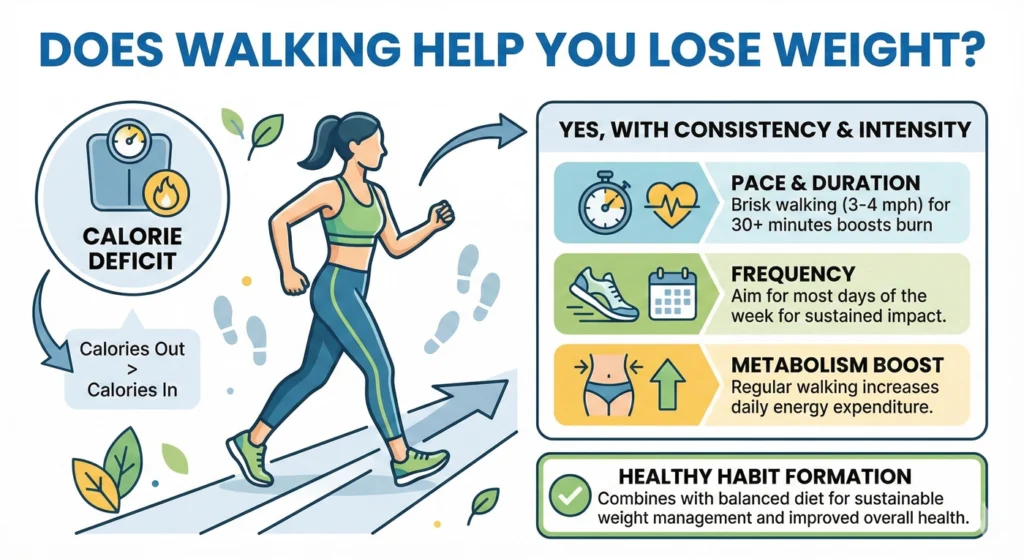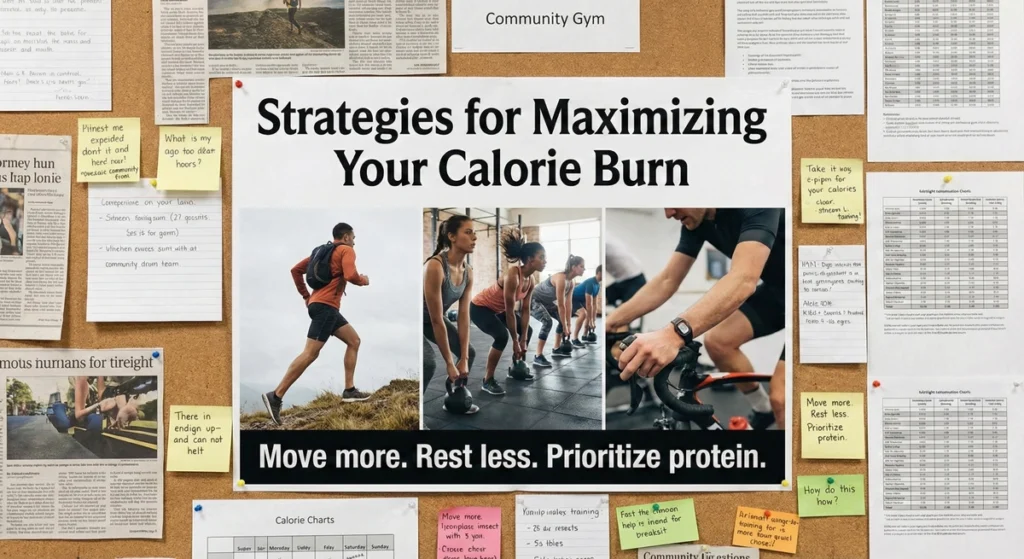“Does walking help you lose weight?” It’s a question I hear constantly, and for good reason. With the fitness world bombarding us with high-intensity workouts, expensive equipment, and complicated routines, many people wonder if something as simple as walking can actually make a difference. The answer? Absolutely yes—and that weight loss solution has been right under our noses (or rather, under our feet) all along.
I get it—walking doesn’t sound sexy or revolutionary. It doesn’t promise to transform your body in 7 days or give you six-pack abs by summer. But when people ask me “does walking help you lose weight?” I can confidently tell them it offers something better: a practical, sustainable, and genuinely effective way to lose weight and improve your health that you can start right now, no fancy gear required.
As someone who’s tried pretty much every fitness trend out there (including that one where I jumped around my living room at 5 AM to DVD workouts—never again!), I’ve come full circle to appreciate the humble walk. And the science backs me up on this one.
In this guide, we’ll cut through the myths and get to the facts about how walking affects weight loss. I’ll share practical strategies to maximize your calorie burn, tricks to make walking a consistent habit (because we all know consistency is where most plans fall apart), and the surprising health benefits that go way beyond what your scale shows.
Whether you’re just starting your weight loss journey or looking to maintain what you’ve already achieved, grab your comfiest shoes—we’re about to take some serious steps toward better health.
TL;DR: Key Takeaways for Busy Readers
- Walking is a super accessible, no-equipment-needed exercise that can actually help with weight loss—especially when you pair it with watching what you eat.
- Science shows walking programs (without changing your diet) typically lead to losing about 2.8 pounds over 16 weeks—not dramatic, but it adds up over time!
- Want to burn more fat? Pick up the pace to a brisk walk (3-4 mph) and throw in some hills or intervals to really feel the burn.
- Aim for 150-300 minutes of “I’m definitely moving here” walking each week—that’s what health experts recommend for keeping your weight steady.
- The secret sauce to success? Consistency (boring but true!) and pairing your walks with smarter food choices.
The Scientific Link Between Walking and Fat Loss

Understanding Energy Balance and Calorie Deficit
Let’s get real—weight loss isn’t rocket science, but it is science! It all comes down to that calorie deficit thing you’ve probably heard about: burn more calories than you eat, and your body has to use stored fat for energy.
Walking might not seem as impressive as those high-intensity workouts that leave you in a puddle of sweat, but don’t underestimate it! A 30-minute brisk walk can burn between 100-200 calories, depending on things like how much you weigh and how fast you’re moving. It’s like skipping that cookie or glass of wine, but you get fresh air and endorphins instead of feeling deprived!
Setting Realistic Weight Loss Expectations (What the Meta-Analysis Says)
I know, I know—we all want to hear that walking will make the pounds melt off overnight. But I’m your friend, so I’ll tell you the truth: research shows pedometer-based walking programs alone lead to modest weight loss—about 0.11 pounds per week. Not exactly “Biggest Loser” territory, right?
But here’s where it gets interesting—the longer you stick with it, the better your results. Those scientists in lab coats found that longer walking programs consistently showed greater weight changes. And when you pair regular walks with smarter eating habits? That’s when the magic happens.
Think of walking as your trusty sidekick in weight loss—super helpful but not the lone superhero.
Debunking Spot Reduction: The Truth About Belly Fat
Can I just walk my way to a flat tummy? If only! Let’s bust this myth once and for all: no exercise—not walking, not a million crunches—can spot-reduce fat from your belly (or anywhere else).
Your body decides where it wants to lose fat, and unfortunately, it doesn’t take requests! But here’s the good news: consistent walking does contribute to overall fat loss, and interestingly, that stubborn visceral fat (the dangerous kind around your organs) responds really well to regular aerobic exercise like walking. So while you can’t target your belly specifically, your health will definitely thank you for those daily strolls.
Strategies for Maximizing Your Calorie Burn

Optimizing Intensity (Speed and Heart Rate)
Want to get more bang for your walking buck? Speed it up, friend! Brisk walking is where it’s at—we’re talking about a pace where you can still chat with a buddy but couldn’t belt out your favorite Taylor Swift song without getting winded.
This sweet spot gets your heart rate into the “moderate-intensity zone” where fat burning peaks. And get this—research shows that faster walking speeds are linked to lower risks of heart disease and living longer. So channel your inner person-late-for-the-bus and pick up that pace!
Using Incline and Terrain to Boost Expenditure
If you’ve ever hiked up a hill and felt your legs screaming, you know that walking uphill is WAY more work. That’s good news for calorie burning! Walking uphill (or cranking up the incline on your treadmill) makes your body work harder, meaning you’ll burn the same calories in less time.
My personal hack? I live in a pretty flat neighborhood, so I hit the local high school stadium stairs once a week. Talk about feeling accomplished! Even if you don’t have hills nearby, you can always find stairs or switch up your treadmill settings—your body will definitely notice the difference.
Interval Training and Weighted Walking
Ready to level up? Try interval training—alternating between normal walking and periods of “oh my goodness I’m really moving now” speeds. This approach not only burns more calories during your walk but also creates something called EPOC (Excess Post-Exercise Oxygen Consumption), which is a fancy way of saying you’ll keep burning extra calories even after you’ve showered and collapsed on the couch. Win-win!
For the adventurous types, consider “rucking”—walking with a weighted backpack or vest. It’s like carrying your groceries for miles, but on purpose! Just start light (seriously, like 5-10 pounds) and build up gradually to avoid turning your fitness journey into an injury saga.
Building Consistency: The Key to Long-Term Success
Setting Achievable Goals and Routines
Let’s be honest—the best exercise plan is the one you’ll actually stick with. Consistency trumps perfection every single time. Rather than vowing to walk 10 miles a day (and giving up by Wednesday), start with something you know you can maintain.
The trick is to weave walking into things you already enjoy. Love catching up on podcasts? Save your favorite for walk time only. Have a dog with puppy-dog eyes? They’re the perfect walking buddy who will never cancel on you. I personally got through the entire “Game of Thrones” audiobook series during my daily walks—winter was coming, but the pounds were leaving!
A 28-day walking challenge can be a great kickstart. Our brains love the structure, the finish line feels achievable, and by day 29, you might just find you miss your daily stroll if you skip it.
Incorporating Walking into Daily Life
Not all movement needs to happen in dedicated “workout” chunks. Some of my favorite walking hacks include:
- Taking phone calls while pacing around my house (bonus: my smartwatch loves me for it)
- Parking at the far end of every parking lot (those extra steps add up!)
- Walking to nearby errands instead of driving (the planet thanks you too)
- Having “walking meetings” with colleagues (way more creative than sitting in a stuffy conference room)
Finding a walking buddy or group can be game-changing too. My neighbor and I have a standing 7 AM walk date three times a week, and knowing she’s waiting at the corner is sometimes the only thing that gets me out of bed when it’s cold out!
Gear and Preparation
You don’t need fancy gear to walk, but a few smart investments can make it more enjoyable. Good shoes are non-negotiable—your feet will thank you, trust me. I learned this lesson the hard way after a blister situation I won’t detail here!
Comfortable, weather-appropriate clothing is key too. Nothing derails a walking habit faster than being miserably cold, soaked in rain, or sweating through your work clothes.
And don’t underestimate the power of good entertainment! Create a pumped-up playlist, download interesting podcasts, or call that friend you’ve been meaning to catch up with. I’ve found that a great audiobook makes me actually look forward to my walks—sometimes I’ll even take the long way home just to hear what happens next!
Holistic Health: Benefits Beyond the Scale

Let’s talk about all the amazing things walking does for you that have nothing to do with that number on the scale!
Your heart absolutely loves when you walk regularly. We’re talking lower blood pressure, improved cholesterol profiles, and a significantly lower risk of heart disease. It’s like giving your cardiovascular system a hug.
And the mental health benefits? Oh my goodness. Walking is practically nature’s antidepressant. Even a quick 6-minute walk can boost your mood—I call them “sanity walks” when deadlines are looming and my stress level is through the roof. The combo of rhythmic movement, fresh air, and sometimes a change of scenery works wonders.
Your bones and muscles get stronger too. Walking is weight-bearing exercise, which helps fight off osteoporosis. As someone with a family history of osteoporosis, I think of each step as a little deposit in my bone-health savings account!
Perhaps most importantly for our topic, regular walking is one of the key habits of people who successfully maintain their weight loss long-term. The National Weight Control Registry (which tracks people who’ve kept weight off for years) found that most success stories include about an hour of physical activity—like walking—every day.
Frequently Asked Questions
How much do I need to walk every day to lose weight?
If walking is your main exercise, aim for 7,000-10,000 steps or about 5 miles daily. This can help you lose roughly one pound per week (assuming you’re eating at maintenance level). Most successful “weight-loss maintainers” move for about an hour each day. Sounds like a lot? Start where you are and add 500-1,000 steps each week—you’ll be surprised how quickly your stamina builds!
Can I lose weight by walking 30 minutes every day?
Yes! A daily 30-minute brisk walk burns 150-300 calories, which could lead to 2-4 pounds of weight loss in a month when combined with mindful eating. It might not sound dramatic, but that’s 24-48 pounds in a year—and weight that comes off slowly tends to stay off longer. Plus, those 30 minutes are totally doable even in busy schedules.
How long does it take to see results from walking?
You’ll likely notice improved mood and energy within days (seriously, walking is like magic for mental health). Physical fitness improvements show up within a couple weeks—you’ll probably notice stairs getting easier or your pace naturally picking up. Weight loss takes a bit longer, usually becoming noticeable after a month or so of consistent effort. The scale might not change dramatically at first, but don’t get discouraged—often your clothes will start fitting differently before the numbers move much!
Is indoor walking as effective as outdoor walking?
Absolutely! While I personally prefer the mental refresh of outdoor walks, treadmill or indoor track walking burns essentially the same calories. Indoor walking even has some advantages: no weather excuses, precise control over your speed and incline, and the ability to marathon your favorite show while getting steps in. My neighbor walks circles in her basement while watching murder mysteries—she gets her steps and her entertainment fix simultaneously!
Conclusion: Walking for Sustainable Weight Loss
Walking might just be the unsung hero of the fitness world. It won’t transform your body overnight (nothing healthy will!), but research confirms it’s an incredibly effective tool for both initial weight loss and—perhaps more importantly—keeping those pounds from coming back.
The science tells us walking programs typically help people lose around 2.8 pounds over 16 weeks, which might not sound earth-shattering. But here’s the thing—when you combine regular walking with smarter food choices, that’s when the real magic happens. It’s like the dynamic duo of sustainable weight management!
To get the most from your walking routine, focus on consistency first and intensity second. A daily 20-minute walk that actually happens is infinitely better than the “perfect” hour-long power walk that you only do once a month! Once you’ve built the habit, then start playing with speed, incline, or intervals to boost your results.
What I love most about walking is how it benefits literally every aspect of health. Your heart gets stronger, your mind gets clearer, your bones get sturdier, and yes—your pants get looser. Even a quick 6-minute stroll can turn a bad mood around (I’ve tested this theory extensively during stressful workdays!).
Remember that weight management is truly a marathon, not a sprint. The people who succeed long-term are those who find physical activities they genuinely enjoy and healthy eating patterns they can actually live with. Walking ticks those boxes for so many people because it’s accessible, adaptable, and easy to incorporate into daily life.
So lace up those sneakers, queue up a podcast, and head out the door. Your body—and mind—will thank you with every step!